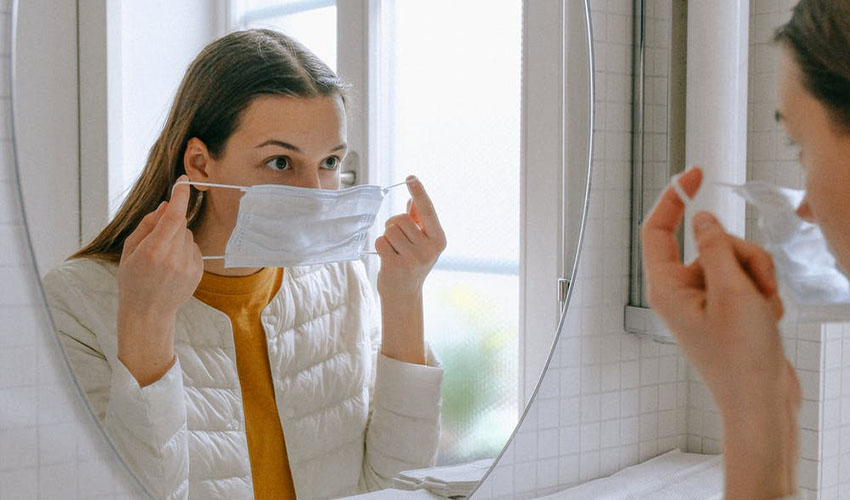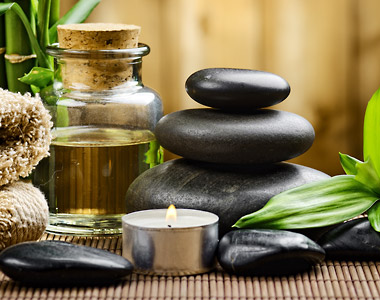
Between personal stress, changed schedules and spa hours, and our own specific circumstances, the last year has seen a lot of changes to our skin care routines. And now, with the increased wearing of face masks during the COVID-19 pandemic, many people are noticing that the skin around their mouth and nose is more prone to acne and blemishes than it was before. Today, let’s look at why this is happening.
Why is my skin breaking out?
Everyone’s skin has a natural protective layer, called the stratum corneum, that helps shield us against bacteria, dirt, and other foreign bodies. However, there are open pores, sweat glands, hair follicles, and other openings all over this layer, and sometimes those foreign bodies can find their way inside.
Wearing a face mask causes excessive moisture, dirt, bacteria, and dead skin cells to get trapped close to your covered skin, and greatly increases the likelihood it will be pushed into one of these openings. In the process, pores can get clogged – a perfect environment for bacteria to multiply and cause a breakout of acne.
How to prevent skin breakouts
The good news is this: by following some simple steps, you can help prevent this build-up of bacteria and keep it away from your face, even as we go about our daily lives in this new normal.
To start, remember to take your mask off as much as possible (while still following current mask guidelines). Try to avoid touching the inside of the mask if you can, as bacteria and other germs can transfer easily from your hands to the fabric. When taking off your mask, allow the moisture of your breath that gets on your skin to dry, as less moisture means less bacterial growth overall.
Never put your mask under your chin and then back up if you are prone to breaking out. This area has a lot of bacteria, particles, and other dirt on it, and a mask put here will bring it all back up and rub it right into the open pores.
Prevent your mask from being contaminated by making sure your skin under the mask area is clean and do not wearing make-up when you need to wear the face mask. Also be very careful with how you handle the mask. When you take your mask off, fold it in half so the interior is folded inside, and set it down or into your pocket with the clean side out.
The most important thing you can do, though, is simply change your mask often. Your mouth and nose have bacteria in them, and they will naturally spread to the mask and the surrounding skin every time you breathe and talk. The longer you go without washing or changing it, the more build-up there is, and the higher chance of a breakout reaction.
What to do if your skin is breaking out
Wash your face properly and regularly.
Get a good product with salicylic acid and healing ingredients for the recovery process, like tea tree oil. If you can, avoid anything with benzoil peroxide – it might work quickly, but there is almost always an acne rebound later. This compound also causes oxidative stress on the skin, creating free radicals that are unhealthy overall.
Use a non-abrasive exfoliant.
Get a product with no “grit” to it, like a cream or a gel that is left on the skin for 10-20 minutes a few times a week. These are better for all layers of skin and they help to remove the top dead layer of skin that often causes a dull complexion or clogged pores.
Switch for a different type of ‘face mask’.
After exfoliation, a treating face mask with compounds like charcoal and coral seaweed extract (also known as coralline officinalis) will help draw toxins out and remineralize the skin. This enhances and promotes healing, without the use of harsh synthetic chemicals.
Moisturize for acne prevention.
Get a moisturizer with plenty of water in it and moisture-retaining humectant properties. If you have generally oily skin, be sure to get a moisturizer that is designed for that skin type – ideally in the form of a gel.
Skin care tips for acne breakouts
Do not pick at acne.
Everyone gives this advice, for good reason – it’s the golden rule of overcoming acne breakouts. Picking at blemishes and blackheads often causes the bacteria to spread, and can even cause permanent scarring and slower healing overall. Resist the temptation and let proper hygiene do the work. A non-gritty exfoliant will be sufficient at helping the clogged pores to unclog and drain.
Follow your skin’s rhythm.
Just like the rest of your body, skin has a circadian rhythm. Research shows that the afternoon is when the skin is most active in producing oil, so if you can avoid wearing a face covering in the afternoon, it could be useful in preventing acne breakouts.
Go for a professional treatment.
When you need it done right, a professional treatment like the Balance Oxygeneo facial can really help restore your skin’s balance. These facials open up pores, allowing them to drain, cleanse, and heal, and they use ingredients like camu-camu extract and mandelic acid – both with proven antioxidant properties – to reduce inflammation and accelerate healing.
At Spa Escape, we offer many other procedures for all circumstances and skin types. Even if you feel like you are dealing with constant breakouts alone, remember that we’re here to help you look and feel your best. Whatever you need for your body to get through these challenging times, our expert staff and technicians can make it happen. Let us know how we can help today!

